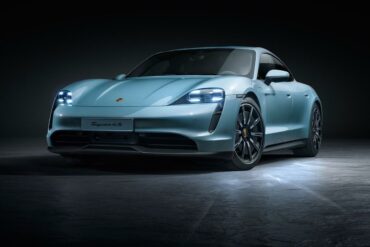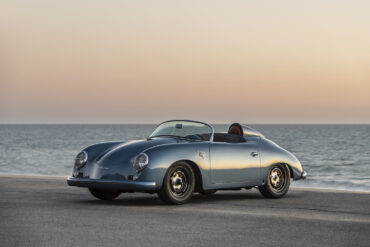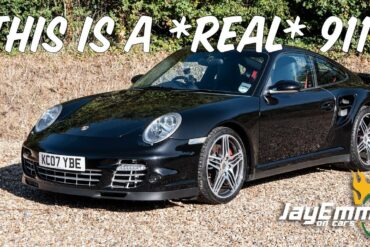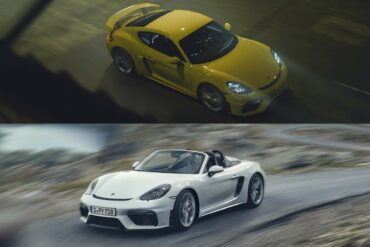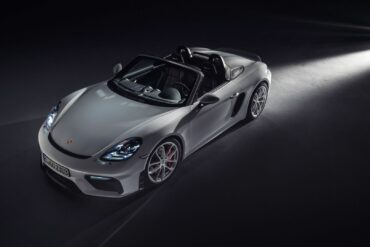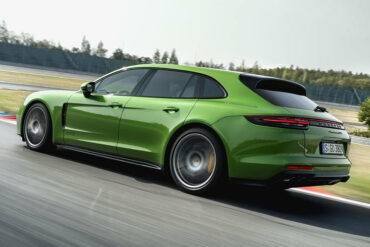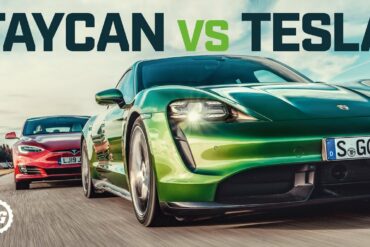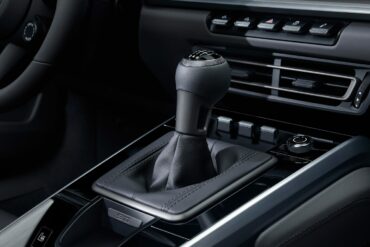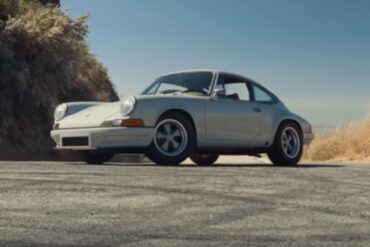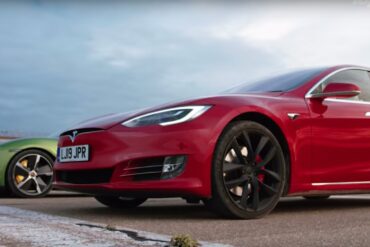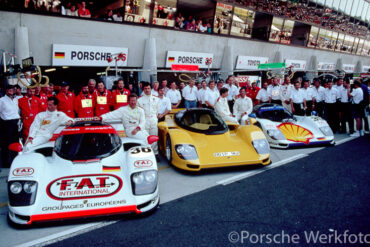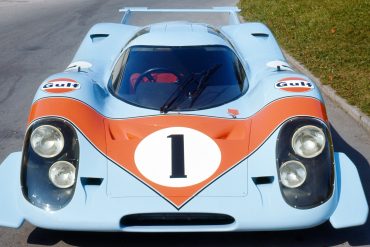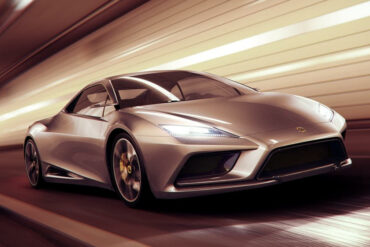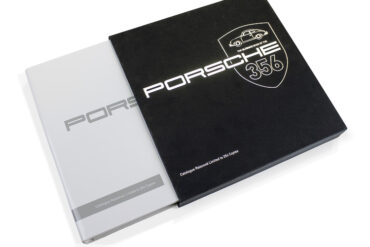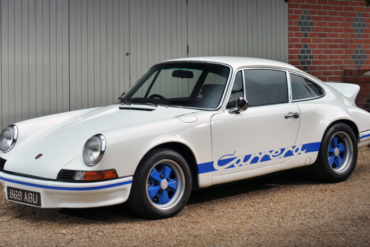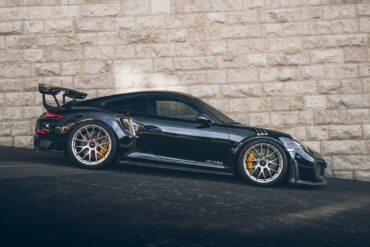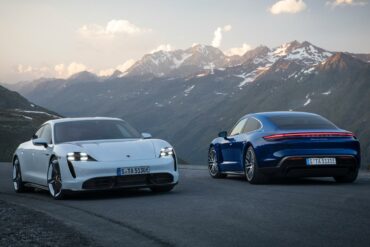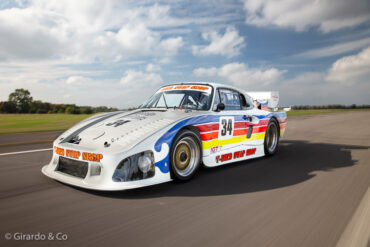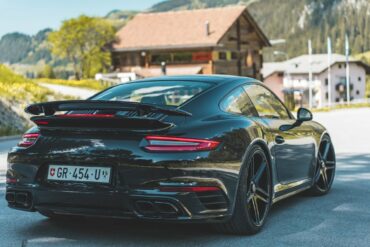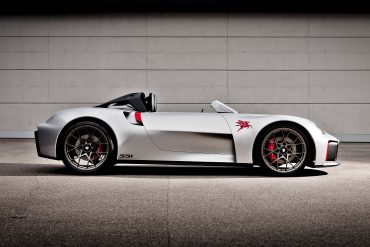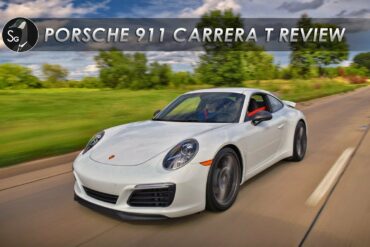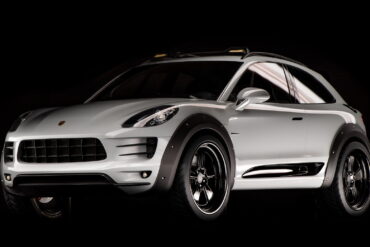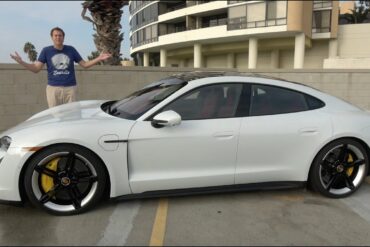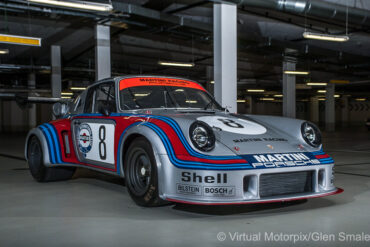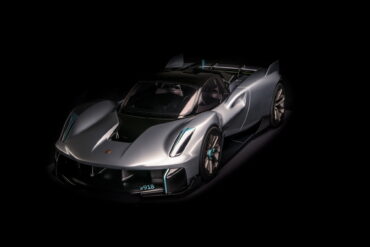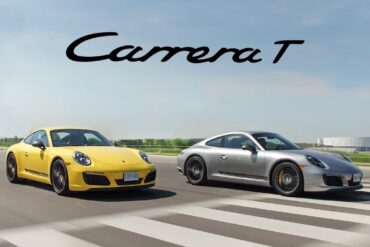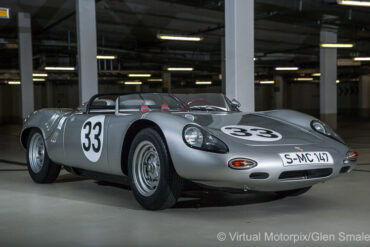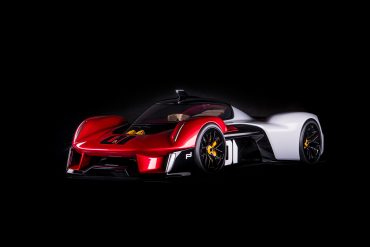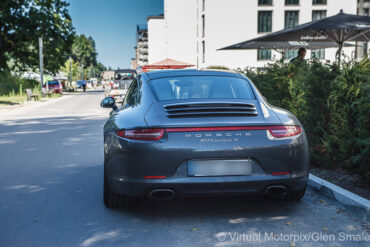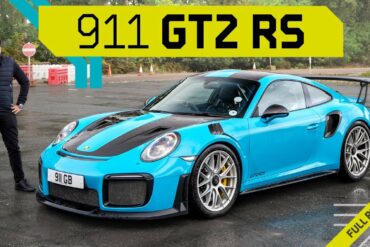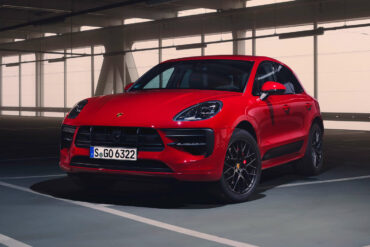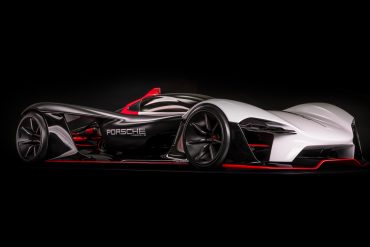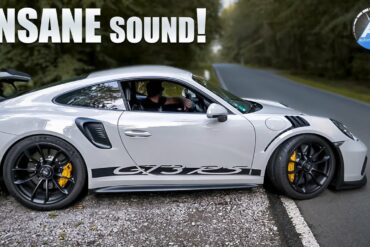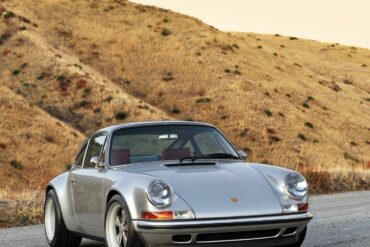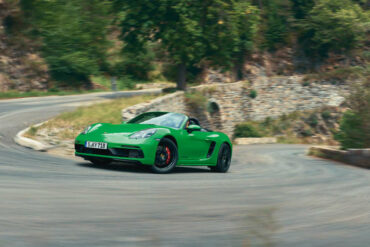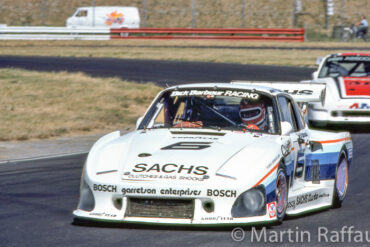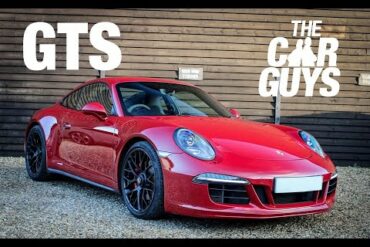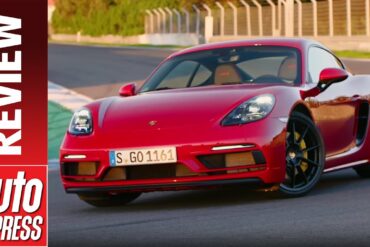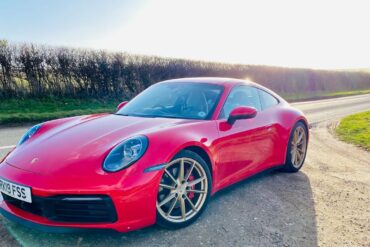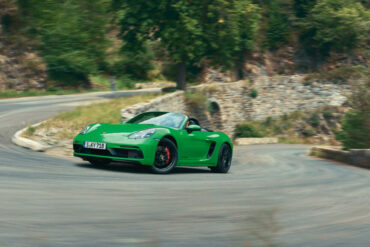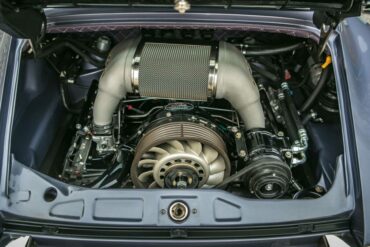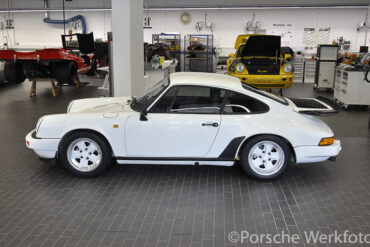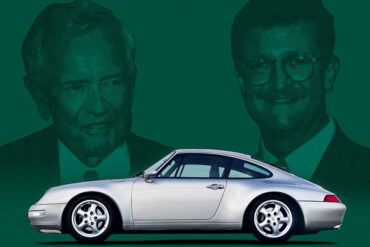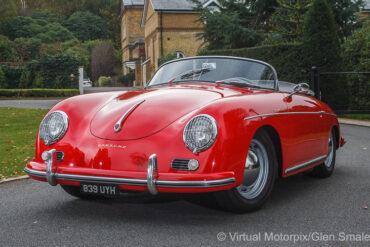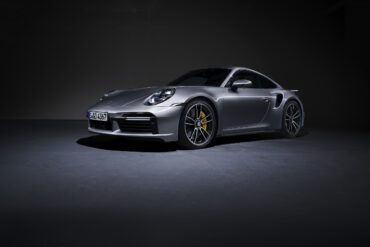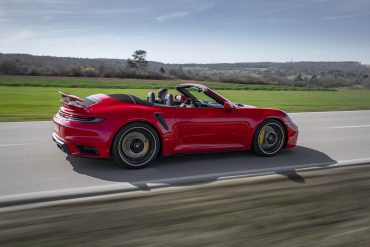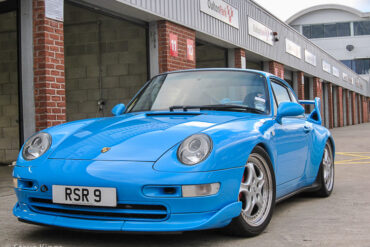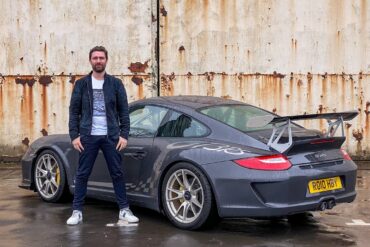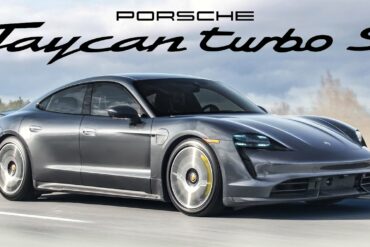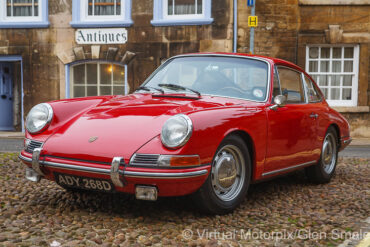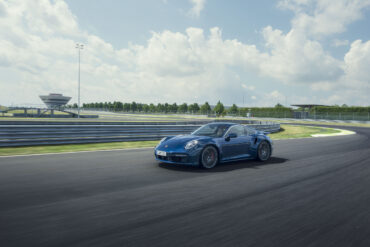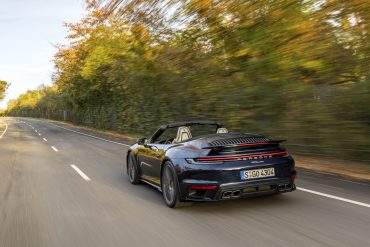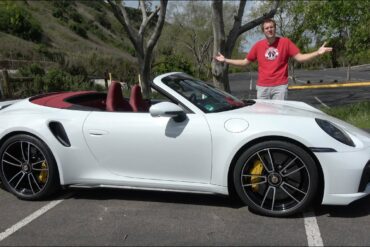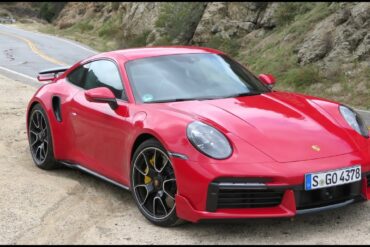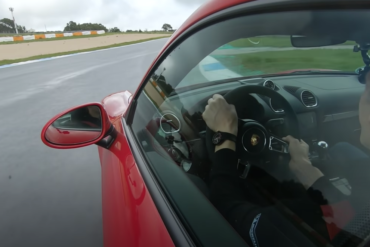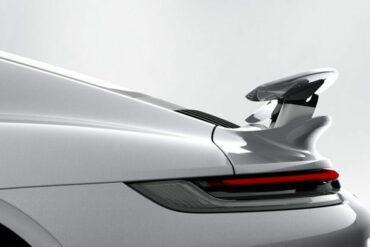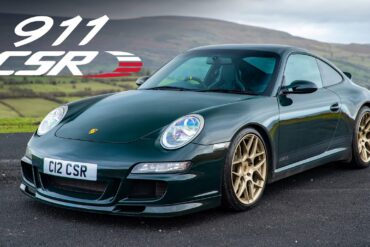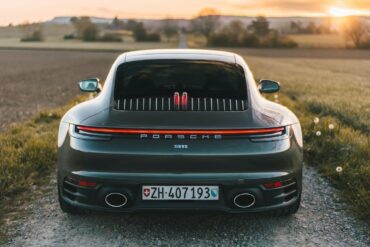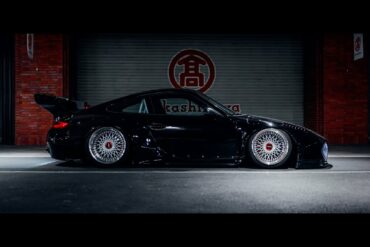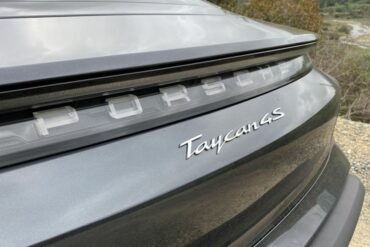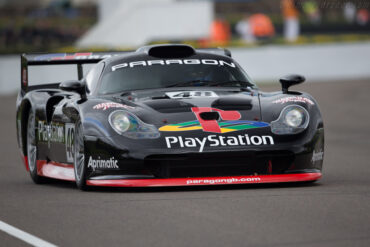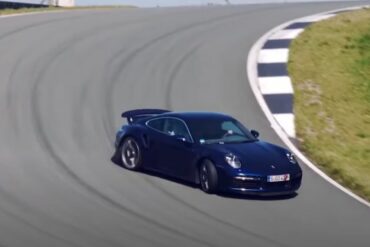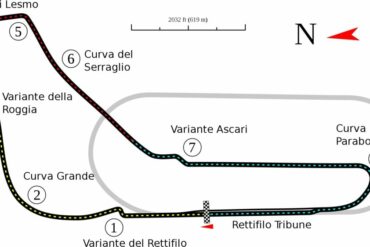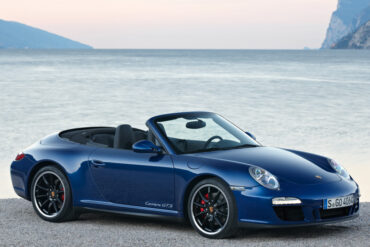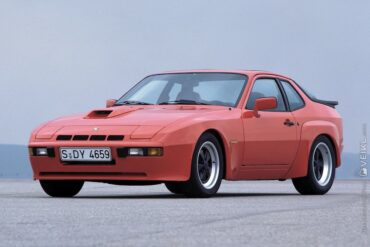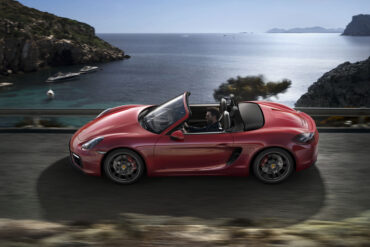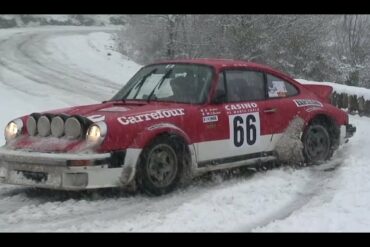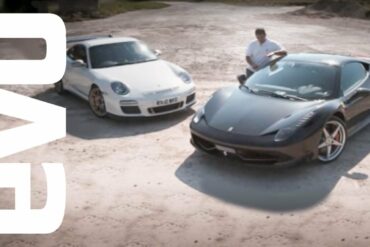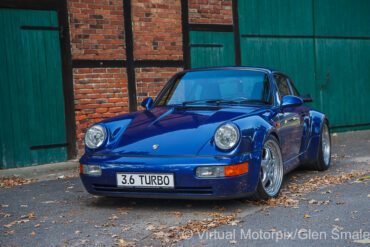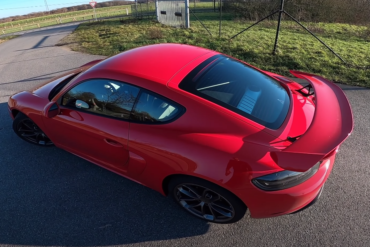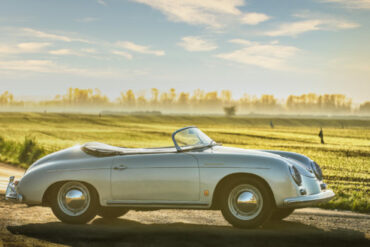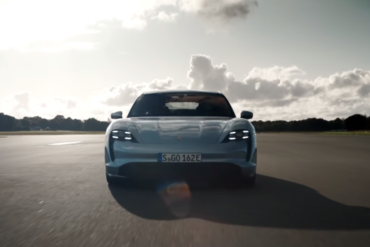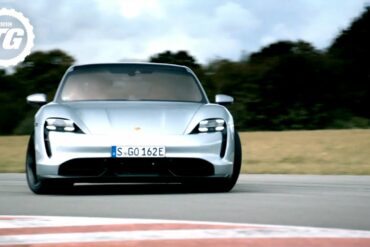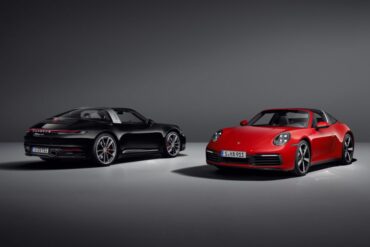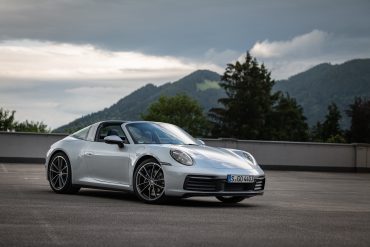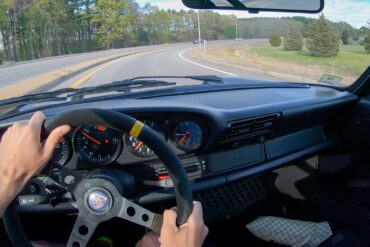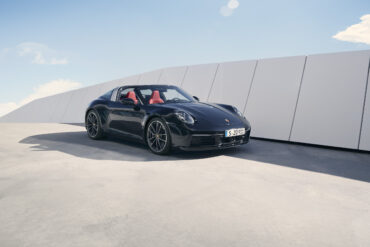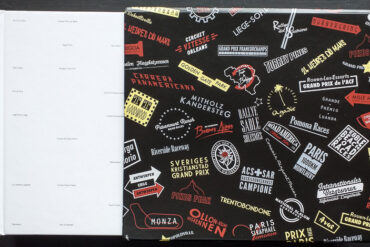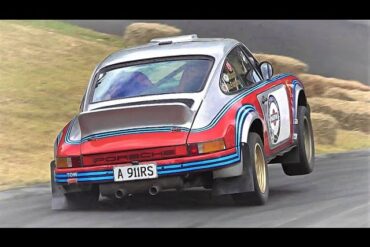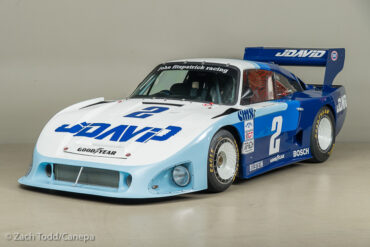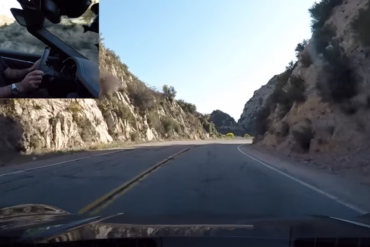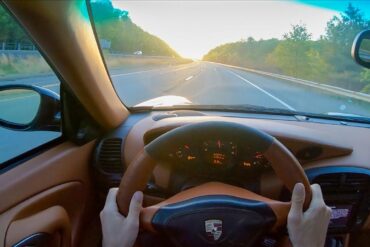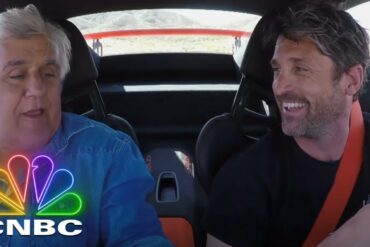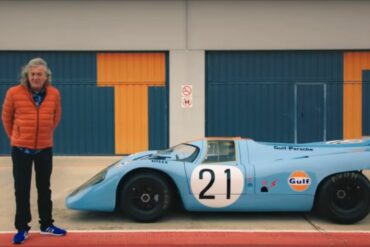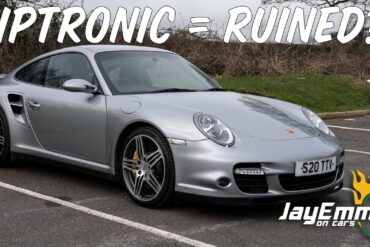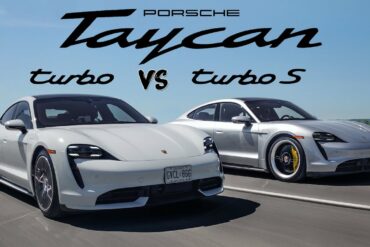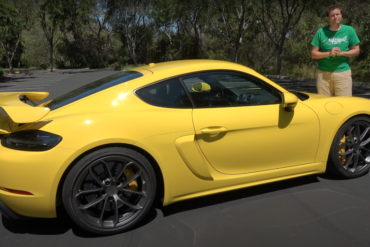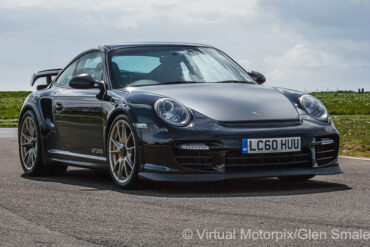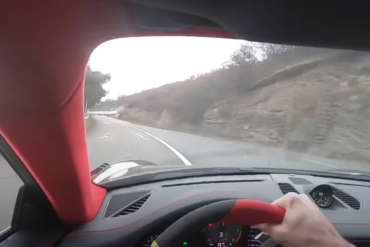The Taycan 4S is the more affordable version of the four-door electric car, but it still offers impressive performance and a high price tag. The Taycan 4S is the sweet spot for Porsche's electric four-door sports car, with more than enough performance for daily driving and enough equipment to feel like it is worth the money. The 4S makes a total of 522 horsepower with its base 79.2-kWh battery pack and 563 horses with the optional one, the 93.4-kWh Performance Battery Plus. Porsche claims a zero-to-60-mph time of 3.8 seconds for the 4S.
Porsche Models
All
- Porsche 914
- Porsche Cayenne 955 (1st Gen)
- Porsche 917K
- Porsche 918
- Porsche 924
- Porsche 928
- Porsche 944
- Porsche 959
- Porsche 962
- Porsche Boxster Concept
- Porsche Carrera GT
- Porsche 911
- Porsche Cayenne
- Porsche RS Spyder
- Porsche Cayman 987 (2nd Gen)
- Porsche Cayman 981 (3rd Gen)
- Porsche Cayenne 957 (1st Gen)
- Porsche Boxster 986 (1st Gen)
- Porsche 718 Cayman 982 (4th Gen)
- Porsche Cayenne 958 (2nd Gen)
- Porsche 356 Pre-A
- Porsche Boxster 987 (2nd Gen)
- Porsche 356 A
- Porsche Boxster 981 (3rd Gen)
- Porsche 356 B
- Porsche 718 Boxster 982 (4th Gen)
- Porsche 356 C
- Porsche 968
- Porsche Panamera
- Porsche Panamera 970 (1st Gen)
- Porsche Panamera 971 (2nd Gen)
- Porsche Boxster
- Porsche Cayman
- Porsche Macan
- Porsche Taycan
- Porsche 912
- Porsche 919
- Porsche 956
- Porsche 2708 Indy
- Porsche Type 64
- Porsche 918 RSR Concept
- Porsche 918 Spyder
- Porsche 918 Concept
- Porsche 918 Spyder Prototype
- Porsche Race Cars
- Porsche 917
- 911 Carrera RS 2.7
- Porsche 550
- Porsche 718
- Porsche 901 (911)
- Porsche Concept Cars
- Porsche 904
- Porsche 906
- Porsche 907
- Porsche 908
- Porsche 910
- Porsche 911 (F-Series)
- Porsche 911 (991)
- Porsche 911 (G-Series)
- Porsche 911 (964)
- Porsche 911 (993)
- Porsche 911 GT1 Race
- Porsche 911 GT1 Street
- Porsche 911 (996)
- Porsche 911 (997)
- Porsche 916
- Porsche 919 Hybrid
- Porsche 934
- Porsche 934/5
- Porsche 935
- Porsche 936
- Porsche Mission E
- Porsche 928
- Porsche 928 S
- Porsche 928 S4
- Porsche 928 GT
- Porsche 928 GTS
- 911 Speedster Concept
- Porsche 928 Specials
- Porsche 928 H50
- Porsche 935 Tribute
- Porsche 928 CS/SE
- Porsche 597
- Porsche Mission E Cross Turismo
- Porsche 551
- Porsche 911 (992)
- Porsche Concept 917
- Porsche Sport Tourer Electric
- Porsche Le Mans Living Legend
- Porsche 960 Turismo Concept
- Porsche 919 Street
- Porsche 904 Living Legend
- Porsche 906 Living Legend
- Porsche 911 Vision Safari Concept
- Porsche Bergspyder Concept
- Porsche Macan Vision Safari
- Porsche Vision 916
- Porsche Vision 918 RS
- Porsche Vision 920
- Porsche Vision E
- Porsche 917 16-Cylinder Prototype
- Porsche 959 Gruppe B
- Porsche Tapiro Concept
- Porsche Carrera GT Concept
- Porsche Taycan 4S
- 718 Cayman GT4 Rallye
- Porsche Taycan Turbo S
- Porsche Taycan Turbo
- Porsche Typ 360
- Porsche 645 Spyder
- Porsche 550 Coupé (Prototype)
- Porsche 550 Spyder (Prototype)
- Porsche 550 Spyder
- Porsche 550 RS Spyder
- Porsche 550A RS Spyder
- Porsche 787 F1
- Porsche 804 F1
- Porsche 904 Carrera GTS
- Porsche 904/6 Carrera GTS
- Porsche 904/8 Carrera GTS
- Porsche 904 Bergspyder
- Porsche 906 Spyder
- Porsche 906 LH Coupé
- Porsche 965 (911)
- Porsche 906 E Carrera 6
- Porsche 942
- Porsche 959 Prototype
- Porsche 906/8 Coupé
- Porsche 906 Carrera 6
- Porsche 969
- Porsche 989
- Porsche 910 Bergspyder
- Porsche 910 Targa
- Porsche C88
- Porsche 909
- Porsche Panamericana
- Porsche 718 RSK Spyder
- Porsche 718 RS 60 Spyder
- Porsche 718 RS 61 Spyder
- Porsche 718 W-RS Spyder
- Porsche 718 GTR Coupe
- Porsche 718/2 F2
- Porsche 718 RS 61 LM Coupé
- Porsche 718 RSK Mittellenker
- Porsche 907 K
- Porsche 907 LH
- Porsche 908/01 LH Coupé
- Porsche 908/01 K Coupé
- Porsche 908/02 K Spyder
- Porsche 908 K Flunder Spyder
- Porsche 908 LH Flunder Spyder
- Porsche 908/03 Spyder
- Porsche 908/03 Spyder Turbo
- Porsche 919 Hybrid Evo
- Porsche LMP2000
- Porsche 984
- Porsche LMP1-98
- Porsche 961
- Porsche 917 LH-69
- Porsche WSC-95
- Porsche 917 K-69
- Porsche 917 ‘Interserie Spyder’
- Porsche 917 K-70
- Porsche 917 K-71
- Porsche 917 LH-70
- Porsche 917 LH-71
- Porsche 917/20
- Porsche 917/10-71
- Porsche 917/10-72
- Porsche 917/10 Turbo
- Porsche 917/20 Turbo
- Porsche 917/30
- Porsche 914/4 (1.7 L)
- Porsche 914/4 (2.0 L)
- Porsche 914/6 (2.0 L)
- Porsche 914 LE
- Porsche 914/4 (1.8 L)
- Porsche 914/8
- Porsche 914-6 GT
- Porsche 924 (Base)
- Porsche 924 Turbo
- Porsche 924 Carrera GT
- Porsche 924 Carrera GTR
- Porsche 924 Carrera GTS
- Porsche 924S
- Porsche 924 Rallye Turbo
- Porsche 924 Carrera GTP
- Porsche 924 SCCA
- Porsche 944 Coupe
- Porsche 944 S Coupe
- Porsche 944 S2 Coupe
- Porsche 944 S2 Cabriolet
- Porsche 944 Turbo Coupe
- Porsche 944 Turbo S Coupe
- Porsche 944 Turbo Cup
- Porsche 944 Turbo Cabriolet
- Porsche 944 GTP
- Porsche 944 Swiss Special
- Porsche 944 French Special
- Porsche 944 Celebration
- Porsche 944 S2SE
- Porsche 968 Coupe
- Porsche 968 Cabriolet
- Porsche 968 CS Coupe
- Porsche 968 Turbo S
- Porsche 968 Turbo RS
- Porsche 968 Sport
- Porsche 959 Rally
- Porsche 959 Komfort
- Porsche Cayenne 9YA (3rd Gen)
- Porsche 959 Sport
- Porsche Boxster (Base)
- Porsche Boxster S
- Porsche Boxster S Special Edition
- Porsche Boxster Spyder
- Porsche Boxster RS 60 Spyder
- Porsche Boxster GTS
- Porsche Boxster T
- Porsche Cayman (Base)
- Porsche Cayman S
- Porsche Cayman GTS
- Porsche Panamera Sport Turismo
- Porsche Cayman GT4
- Porsche Cayman R
- Porsche Macan 95B (1st Gen)
- Porsche Macan (Base)
- Porsche Cayman S Black Edition
- Porsche Macan S
- Porsche Cayman S Sport
- Porsche Macan GTS
- Porsche Cayman S Design Edition 1
- Porsche Cayman T
- Porsche Macan Turbo
- Porsche Taycan (Base)
- Porsche Cayman GT4 Clubsport
- Porsche Taycan 4
- Porsche 718 Boxster 25
- Porsche Formula E
- 964 Carrera 2
- 964 Carrera 4
- ’30 Jahre’ Anniversary
- 964 Speedster
- 964 Turbo
- 964 Carrera RS
- 964 Carrera Cup
- 964 RSR
- 993 Carrera
- Porsche Cayman GT4 RS
- 911 Edition 50
- 993 Carrera 4
- 911 2.0 Bertone Roadster
- Porsche Macan T
- 993 Carrera 4S
- Porsche Mission R Electric
- 993 Carrera S
- 993 Targa
- 992 Sport Classic
- Porsche Vision Gran Turismo
- 993 Turbo
- 993 Carrera RS
- 996 Carrera
- 993 GT2
- 996 Carrera 4
- 992 America Edition 911
- 993 Carrera Cup
- 996 Targa
- 996 Carrera 4S
- 996 Turbo
- Porsche 963
- Porsche 718 Cayman GT4 ePerformance
- 996 Turbo S
- 996 GT3
- 996 GT3 RS
- 718 Boxster
- 996 GT2
- 996 GT3 Cup
- 996 GT3 R
- 996 GT3 RSR
- 996 GT3 RS Race
- 997 Carrera
- Porsche 991 (991)
- 997 Carrera S
- 997 Carrera 4
- 997 Carrera 4S
- 997 Targa
- 911 Carrera 3.0 Coupe (G-Series)
- 997 Targa 4S
- 997 Turbo
- 997 Turbo S
- 992 Carrera T
- 997 GT2
- 997 GT2 RS
- 997 Speedster
- 997 Carrera GTS
- 992 Dakar
- 997 Carrera 4 GTS
- 997 GT3 Cup
- 997 GT3 R
- 997 GT3 RSR
- 997 GT3
- 997 GT3 RS
- 991 Carrera
- 997 GT3 R Hybrid
- 991 Carrera 4
- 991 Carrera S
- Porsche 981
- 991 Carrera 4S
- 991 Targa 4
- Porsche Vision 357
- 991 Targa 4S
- 991 Turbo
- 991 Turbo S
- 991 Carrera GTS
- 991 Carrera 4 GTS
- 991 Targa 4 GTS
- Porsche 961
- 991 911 R
- Porsche 992 GT2 RS
- 991 GT3
- 991 GT3 RS
- 991 GT2 RS
- 991 Speedster
- 991 GT3 R
- 991 GT3 Cup
- 991 RSR
- Porsche 962
- Porsche Cayenne (4th gen)
- 991 Carrera T
- 992 Carrera 2
- 992 Carrera 4
- Porsche Type 540 America Roadster
- 992 Carrera S
- Porsche 718 Spyder RS
- 992 Carrera 4S
- 992 Targa 4
- 992 RSR
- Porsche Mission X
- 992 Targa 4S
- 992 Carrera GTS
- 992 Carrera 4 GTS
- 992 Targa 4 GTS
- Porsche RS60 Spyder
- 992 Turbo
- 992 Turbo S
- 992 GT3 R
- 992 GT3
- 992 GT3 Touring
- 992 911 S/T
- 992 GT3 RS
- 911 (G-Series)
- 992 GT2 RS
- 911 Carrera 3.0 (G-Series)
- 992 GT3 Cup
- Porsche Taycan GTS
- Porsche 356 SC
- 911 S (G-Series)
- Porsche Mission X
- 911 Carrera RSR 2.8
- 911 SC (G-Series)
- Porsche 992 GT3 R Rennsport
- 911 S/T
- 911 (Base Model)
- 911 Carrera 3.2 (G-Series)
- 911 Turbo (930)
- 911 SC Safari
- 911 L
- 911 T
- 911 Carrera RSR Turbo 2.1
- 911 Carrera RSR 3.0
- 911 E
- 911 SC San Remo
- 911 S
- 911 R
- Pre-A Speedster
- Porsche 953
- Porsche 356
- 911 Carrera 3.2 Clubsport
- 911 Turbo LE
- 911 Carrera RS 3.0
- 911 T/R
- Porsche Panamera (3rd gen)
- 911 SC RS
- 911 Carrera 25th Anniversary
- Beutler Coupe
- 911 Turbo 2.7
- 911 3.2 Speedster
- 911 Carrera 2.7 (G-Series)
- 911 Carrera Commemorative
- Porsche 911 GT1
- Porsche 99X Electric
- Porsche Macan 4
- 964 Turbo S
- Taycan Turbo GT
- Porsche Panamera 972 (3rd gen)
Shifting the Recipe a Bit Rod Emory of Emory Motorsports has revealed the 1959½ Speedster. It’s the latest evolution of...
I’m a 911 fan, through and though – but my last experience of a turbo-powered Porsche was very disappointing. I...
Vox Automobili Tested the Cars The Tesla Model S P100D and the Porsche Taycan Turbo S are well-suited rivals. The...
The 718 Boxster Spyder is everything you could possibly want in a sports car. The sublime combination of a legendary chassis and naturally aspirated 6-cylinder Porsche engine is accentuated by the emphasis that less is more when done right - and nobody does this better than Porsche’s GT division. Connections with these cars are visceral and emotional, an outcome mutually desired by both Porsche engineers and customers alike. They will never be considered tardy in the right hands. The Spyder is in my opinion, the best sports cars you can buy in this segment.
For the 2019 model year, the second-gen Panamera is now a beneficiary of the badge - which actually stands for ‘Gran Turismo Sport’ - that has come to represent the pragmatist’s choice of Porsche automobile. The Panamera GTS is also now available in a long-roof wagon body style, dubbed the Sport Turismo. In totality, this is the vehicle I will be writing about - the 2019 Porsche Panamera GTS Sport Turismo. Traditionally speaking, the GTS version of any Porsche has typified a “sport-plus” version of a mid-level trim within the model range.
Porsche 993 Cup 3.8 RSR On Track Video dedicated to a 1995 Porsche 993 Cup 3.8 RSR driven by Ralph...
Which is Better? Porsche Taycan Turbo S vs Tesla Model S It’s the EV heavyweight battle you’ve been waiting for: In...
Yes, the Stick Is Available The manual transmission of the 992-generation 911 from Porsche was already promised but now it...
Is This the Holy Grail of Porsches? If you didn’t know about Workshop 5001, then get ready to meet the...
The Car Videos You Shouldn’t Overlook Every couple of weeks we take time to dig through the video content that...
Lined up in the pit lane before the 1994 Le Mans 24-Hours, is from the left: #36 962 Dauer Le...
50 years of the Porsche 917 Anniversary The most famous racing car of all time made its debut at the...
It Sounds Like It Lotus has long been held up as one of the best sports car manufacturers out there....
The Ultimate Book of the Porsche 356 by Brian Long © Veloce Publishing Limited Brian Long’s original book on the...
Porsche 911 Carrera RS 2.7 1973 Porsche 911 Carrera RS 2.7 Engine: 2,687 cc, air-cooled horizontally flat six Production dates:...
My Friend Bought A Stealth Porsche GT2 RS Weissach!! In this weeks episode I take my friends new 991.2 GT2...
It is expensive, it is fast and it is exceptional. The Porsche Taycan Turbo shows us that Porsche's electric future is going to be great for drivers. The Taycan Turbo feels even relentlessly rapid at any speed and the best part is that it really feels like a Porsche from behind the wheel. The Turbo has the same 93.4kWh battery stack as the Turbo S, and the same 614bhp power output. But when you’re going for it in Performance mode, the Turbo’s overboost power and torque are reduced compared with the Turbo S. It means the Turbo is four-tenths slower to 60 mph from standstill.
Porsche 996.1 v 996.2: Every Detail Revealed The Porsche 996 Carrera is on a crest of a wave in popularity...
Kremer Porsche 935 K3 – chassis #930 890 0021 The Porsche 935 was the Stuttgart manufacturer’s answer to the FIA’s...
2020 Porsche 911 Review Would you take it over the 991 911, Corvette C8, Nissan GTR, Audi R8? The guys...
Tuned 911 Turbo S On the Road I am a big fan of the Cars With Luke channel and in...
The 551 Vision Spyder was built in 2019 but kept a secret until its unveiling this week. Billed as a 21st century reimagining of the 1954 machine that made Porsche’s name, in fact it’s really an hommage to one particular car, James Dean’s Little Bastard, wearing the race number 131 (Dean’s was 130) and the licence tag “Little Rebel”.
Porsche 911 Carrera T In Depth We review the last model year of the 991.2 Porsche 911 Carrera T. The...
The Porsche Macan Vision Safari is a 3-door compact SUV coupe concept, designed and built by Porsche in 2013, essentially showing what would be an off-road Porsche Macan. The concept only had two doors compared to the four in the normal SUV, and came with a host of off-road-oriented accessories, some of them including an increased ride height, larger front and rear tires.
Doug DeMuro Reviews the Taycan The 2020 Porsche Taycan is the best new Porsche — and one of the most...
The year 1974 will be remembered for many different reasons, depending on where you were living in the world at...
The Porsche Vision 918 RS is a supercar concept, designed and built by Porsche in 2019, to preview what essentially could be the next generation of a trackday, street-legal Porsche 918 if it were still in production. Some of the design elements, none of which bear resemblance to the original Porsche 918, include sharp and soft creases and large air intakes, three fins on the widened rear fenders and roof.
Reviewing The Purist Porsche We go for a drive in the 2018 Porsche 911 Carrera T Manual and PDK....
1961 Porsche 718 W-RS Spyder ‘Grossmutter’ (chassis #047) photographed at the Porsche Museum, May 2019 The word unique is a...
The Porsche Vision 920 is a race car concept, designed and built by Porsche in 2019, to preview what essentially could be a successor to their highly successful LMP1 race car, the Porsche 919 Hybrid. Porsche says the company designed the concept as either a super sports car for the road or as a possible racing car that could be used in a customer motorsport series.
991.2 GT2 RS – Most Powerful 911 Driven Porsche‘s Most Powerful 911 ever!! The Legendary GT2 RS! When a 911 Turbo...
The Audi SQ5 Had Better Watch Out Porsche has more competition than ever before for its SUVs. The 2020 Porsche...
The Porsche Vision E is a race car concept, designed and built by Porsche in 2019, to preview what essentially would be a future customer race car from Porsche. Using technology from their Formula E race car, the Porsche 99X, the company says that this concept would preview what would be a race car that private individuals can drive, to get the closest feel to Formula E in terms of performance and driving dynamics.
Porsche 991.2 GT3 RS – Turn Up the Volume Unbelievable once-in-a-lifetime DRIVE & SOUND with the recent 2018/2019 Porsche 991.2...
There is nothing better Bitten by the car bug at an early age, Shawn was drawn around the aura of...
Singer Vehicle Design – Mexico Commission Today, we take a closer look at the Singer Vehicle Designs Mexico Commission. At...
Paul Stephens 320 Clubsport Series II Review This is the Paul Stephens 320 Clubsport Series II and it is a...
Kicking the Four-Pot to the Curb In the new 718 Boxster and Cayman GTS, Porsche has replaced the 2.5-liter turbocharged...
The cars come around for the start – Fitzpatrick (left) and Moretti (right) lead the pack By the time the...
The Porsche 911 GTS (991.1) Review Jason continues his quest to find the best modern Porsche 911 for all occasions....
AutoExpress Reviews the 718 Cayman GTS On the surface, it might seem like a curious decision on Porsche’s behalf to...
Is the new 992 the best 911 of all? The 992 version of Porsche 911 was launched in 2019. The...
Carfection on YouTube released their road review of the new 2020 Porsche Boxster GTS 4.0 yesterday. Using essentially the same...
While not exactly the first person you’d call a car guy, Bill Gates has owned some pretty impressive cars in...
Porsche 911 Carrera 3.2 Clubsport (1985) in the Museum workshop As I’ve explained on the few occasions I’ve burst into...
PORSCHE 993 “25 YEARS” 1994–2019: by Andreas Gabriel, Manfred Hering & Thomas Nehlert © Berlin Motor Books Berlin Motor Books,...
1957 Porsche 356 A Speedster – looking chocolate box pretty! It was Max Hoffman, the New York-based Porsche importer, who...
The current Turbo S comes with an all-new, 3.8 liter boxer six with two variable turbine geometry (VTG) turbochargers. The power output is a staggering 640 HP and 590 lbs-ft of torque. In keeping with previous Turbo models, the engine powers all four wheels. A new 8 speed automatic transmission with a manual mode manages the power, and can power the car to 60 MPH in a hair under a claimed 2.6 seconds. This is a staggeringly quick and capable car.
Porsche 356 – Made by Reutter: by Frank Jung © Delius Klasing Verlag When the second edition of this fine...
The 2022 Porsche 911 Turbo S Cabriolet is a formidable beast. The new Turbo S comes with an all-new, 3.8 liter boxer six with two variable turbine geometry (VTG) turbochargers. The power output is a staggering 640 hp and 590 lbs-ft of torque. In keeping with previous Turbo models, the engine powers all four wheels. A new 8 speed automatic transmission with a manual mode manages the power, and can power the car to 60 mph in a hair under a claimed 2.7 seconds.
Porsche 993 Carrera RS ‘RSR 9’ parked in the pit lane at the 10th RS Track Day Oulton Park, March...
Porsche 997.2 GT3 RS Video Review This is the Porsche 997.2 GT3 RS and we’re back for Season Two of...
Porsche’s $250,000 Electric Monster 2020 Porsche Taycan Turbo S Review by The Straight Pipes. The Porsche Taycan Turbo S is...
It would be a disservice to call this new Turbo a "lesser" car than the Turbo S, but it does have less in most departments. Less power at 573 HP. Less features compared to the jam-packed Turbo S. Most importantly, less money required to put one in your garage. This also is not to say that the new Turbo isn't anything short of a monster. It will still go 0 to 60 in 2.8 seconds, will corner like it was on rails with Porsche Torque Management (PTM) all-wheel-drive.
All Porsche 911s are turbocharged these days but the Turbo model is something special. It gets the twin-turbo 3.7-liter flat six with tons of power and a huge $33,000 savings over the Turbo S. Thanks to an output of 573 hp, marking an increase of 32 hp over the predecessor, the new 911 Turbo Cabriolet accelerates from 0 to 60 mph in 2.8 seconds (0.2 seconds faster than before). The Turbo Cabriolet basically handles like a coupe.
In Depth Review of the 992 Turbo S The 2021 Porsche 911 Turbo S (992) is the ultimate 911 —...
Porsche’s 2021 Turbo S Video Review The all-new 2021 Porsche Turbo S is a tamed beast. It’s got 640 horsepower,...
There is a track drivers dream currently from Porsche in the 718 Cayman GT4. It has been known for a...
The guys at Carfection just posted this awesome video of the latest 718 Cayman GTS 4.0 and boy does it...
Autoblog today published an in depth article investigating the new aerodynamic features of the upcoming 2021 Porsche 911 Turbo S. Not...
Henry Catchpole Reviews A Bespoke 911 CSR ...
Why I Loved The Porsche 992 Carrera 4S! My first drive in the brand new 992 Carrera 4S, what do...
A Special Widebody 997 Had the pleasure of shooting Mun’s crazy Old & New widebody and bagged 997. Special thanks...
When Porsche initially introduced the 2020 Taycan model range, they were claiming that it, with “normal” driving, could reach about...
There’s no doubt about it: the 911 GT1 EVO is still one of the best looking Porsches ever made and...
The Germans are a very interesting bunch. They are friendly, helpful, have good beer and great food. But they are also...
Drifting is generally reserved for cars with massive power, rear wheel drive, and all the electronic goodies turned off. So...
The GTS was powered by the same engine that was installed under the limited-edition Porsche 911 Sport Classic, but it was offered with more options. It wasn't just a driver's car, it was built for the passenger as well, with more options for comfort. From the outside, the Carrera GTS Cabriolet featured the same wide body as the Carrera 4 Cabriolet. At the front, the sport design apron featured a black lip-spoiler underneath. The Carrera GTS logo was painted on the doors. In the back, the car was fitted with LED taillights and four-round exhaust pipes. The 19” light-alloy wheels with central log-nut were fitted as standard.
In 1979, Porsche unveiled a concept version of the 924 at the Frankfurt Auto show wearing Carrera badges. One year later, in 1980, Porsche released the 924 Carrera GT, making clear their intention to enter the 924 in competition. By adding an intercooler and increasing compression to 8.5:1, as well as various other little changes, Porsche was able to develop the 924 Turbo into the race car they had wanted, dubbing it the "924 Carrera GT". 406 examples (including prototypes) of the Carrera GT were built to qualify it for Group 4 racing requirements.
The two most powerful and fastest mid-engine sports models from Porsche are ready and raring to go: with uprated engines and excellent PASM chassis the Boxster GTS and Cayman GTS set new benchmarks for sportiness in their segment. 3.4 L naturally aspirated flat 6 is good for 330 hp. Sport Chrono package is standard. This means that in conjunction with the optional Doppelkupplungsgetriebe (PDK) and the active Sport Plus button, the Boxster GTS sprints from 0-100 km/h in 4.7 seconds.
Best of Porsche Rally Cars...
Chris Harris Drives The Ferrari 458 Italia & Porsche 911 GT3 RS Ferrari’s latest 562bhp V8 coupe has changed the...
Engine based on modified 3.6 litre 964 unit. Speedline wheels with big red brake calipers. Lessons learned in the Carrera Cup series proved the reliability of the new 3.6-litre engine. An additional three millimetres on the bore and two millimetres on the stroke, resulted in an increase in capacity of 300 cc. Combined with the turbo optimised cylinders, pistons and crank train, and an increase in the compression ratio from 7.0 to 7.5:1, this helped to boost power to 360 bhp. Torque was increased significantly to 520 Nm at 4200 rpm, up from 450 Nm at 4500 rpm in the earlier car.
I absolutely love the videos that come out from the guys at AutoTopNL. They have this cool in-car view that does...
A True Porsche Specimen The Porsche 356A Speedster is a beautiful car and an important part of Porsche’s long motoring...
Video Review Porsche Taycan Turbo S The most exciting Porsche model right now is easily the Taycan Turbo S. Sure...
The Taycan Turbo S Top Gear Review Amidst Tesla’s domination of the performance EV world, here’s Porsche’s answer – the...
This morning, as was teased last week, on Porsche’s own 9:11 Magazine online “TV” channel, the new Type 992 911...
While the base Targa isn't the most dynamic 911, it will suit a certain buyer well. If you want the sexiest looking 911 that is a great all-rounder and you don't plan on spanking it all the time, then this is a great 911 to buy. Even in lower-powered form, the 3.0-liter is a peach of an engine. Torquey across its rev range, it responds quickly to prods of the throttle. The real problem with the Targa is the added weight and the structure, which hurts it dynamically.
911 3.2 Carrera POV Run Onramps and Highway driving in my Aircooled 1988 Porsche 911 3.2 Carrera. Be sure to...
Like the standard 4S, the Targa 4S produces 443 bhp @ 6500 rpm from a six-cylinder, 3.0-litre boxer engine with twin turbochargers, and puts it to the road via an eight-speed PDK and Stuttgart's refined all-wheel-drive system. 390 ft lbs from as low as 2300 rpm also means you have tons of mid-range power on tap for any situation. Compared to the previous generation Targa 4S, the new model is up 23 hp and 22 ft lbs of torque.
Porsche 911 Turbo 996 Review We review the 2002 Porsche 911 Turbo 996 and discuss the good and bad of...
911 Owner Stories: Dan and his 993 Carrera 4S At a young age, Dan Brunn moved from Tel Aviv to...
Singer Vehicle Design – Westlake Commission Today, we take a closer look at the Singer Vehicle Designs Westlake Commission. The...
SportErfolge: by Tony Adriaensens – page photographs by © Virtual Motorpix/Glen Smale Simply titled, SportErfolge (English: Success in Sport), this...
Now That’s What I Call Driving This is Stuart McFarlane´s beautiful Porsche 911 SC Safari, a 1974 machine built to...
1981 Porsche Kremer 935 K4 – chassis #K4-01 In the mid-1970s, Porsche developed the 911 for racing, and in the...
Making The Case For Sticking With Manual We’ve covered three different versions of Porsche’s 992 so far: The Carrera S,...
POV Test Drive of Crazy Tuned 996 Turbo Wear headphones! The audio in this video was recorded with in-ear binaural...
Driving A Legend Patrick Dempsey and Jay Leno take a joy ride in a 1973 Porsche Carrera RS 2.7. With...
In our series of looking back at the racing icons of history this month, in preparation of global motorsports returning...
Porsche 911 997 Turbo PDK Review Today I’m driving Scott’s 911 997 Turbo. This car is equipped with the tiptonic...
Taycan Turbo vs Turbo S Comparison 2020 Porsche Taycan Turbo Review and 2020 Porsche Taycan Turbo S Review by The...
Ferrari F355 vs Porsche 911 Carrera 993 RS 3.8 Drag Race From a Japanese car show in the 1990s, an...
His Favorite New Porsche Are you a Porsche fan? Who isn’t, right? Well, that means you’ll love this video of...
2010 Porsche 911 GT2 RS (Type 997), Llandow Circuit, Cardiff, Wales, UK (2014) The GT2 has been Porsche’s top performing...
I have watched a lot of supercar videos on Youtube in my time and this one may be my favorite....


